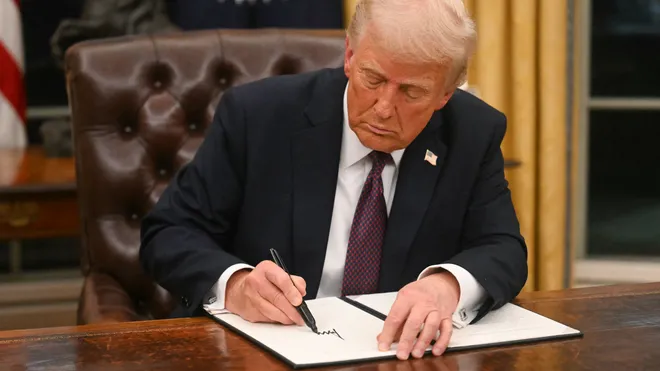
Observers raise questions about AI-crafted executive orders
Legal experts and political observers are pointing to suspected artificial intelligence (AI) use as the culprit behind the “slipshod” and often confusing language found in many of Donald Trump’s executive orders during his second term. Economist Robert Reich recently claimed on X that 16 executive orders signed on Donald Trump’s first day in office appear to have been directly lifted from the Heritage Foundation’s “Project 2025” plan, a blueprint for the Trump administration’s priorities. Trump, however, denied any knowledge of the document during his campaign.
Evidence of AI influence: “Grade-school level language”
Critics argue that the awkward phrasing and stilted language of Trump’s executive orders resemble AI-generated text. A Houston-based appellate lawyer, Raffi Melkonian, highlighted one such order, titled “Restoring Names That Honor American Greatness”, which proposed renaming the Gulf of Mexico to the “Gulf of America.”
The language in the order reads: “The Gulf is also home to vibrant American fisheries teeming with snapper, shrimp, grouper, stone crab, and other species, and it is recognized as one of the most productive fisheries in the world, with the second largest volume of commercial fishing landings by region in the Nation, contributing millions of dollars to local American economies.”
Melkonian called this section “absolutely written by AI” and described it as akin to a “grade-school textbook,” designed, he quipped, “for morons.”
Garbled orders spark ridicule and legal concerns
One of the most controversial orders from Trump’s administration declared that “males and females are the only genders that exist” and that gender is “determined at conception.” This decree not only sparked significant backlash but also contained glaring scientific inaccuracies.
The National Library of Medicine explains that embryos are “phenotypically female” at conception, with male characteristics developing only after six weeks. Delaware Representative Sarah McBride, the first openly transgender person elected to Congress, mocked the order, noting that Trump’s logic essentially declared “everyone a woman.”
The order’s convoluted language compounded its issues, describing genders as “a person belonging, at conception, to the sex that produces the small reproductive cell” and “a person belonging, at conception, to the sex that produces the large reproductive cell.” Legal experts, like Slate journalist Mark Joseph Stern, described this language as “poor, slipshod work” that appears heavily influenced by AI.
Experts question strategy behind Donald Trump’s legal framework
The chaotic and error-prone nature of these executive orders could present serious legal challenges for Trump’s administration, as many are expected to face scrutiny in court. Stern remarked on Bluesky that Trump’s team had promised to avoid the mistakes that marred his first term, which saw many executive actions struck down in court due to their poorly crafted language.
“Lots of reporting suggested that, this time around, Donald Trump and his lawyers would avoid the sloppy legal work that plagued his first administration so they’d fare better in the courts,” Stern said. “I see no evidence of that in this round of executive orders.”
The suspected use of AI in drafting legal documents raises significant concerns about the professionalism and accountability of Trump’s administration. While AI tools can streamline tasks, experts argue that relying on them for high-stakes legal language risks creating incoherent or scientifically inaccurate policies. As criticism mounts, Trump’s team has yet to comment on the allegations of AI involvement. For now, the administration’s executive orders continue to draw scrutiny for their content, structure, and potential impact on American governance.





